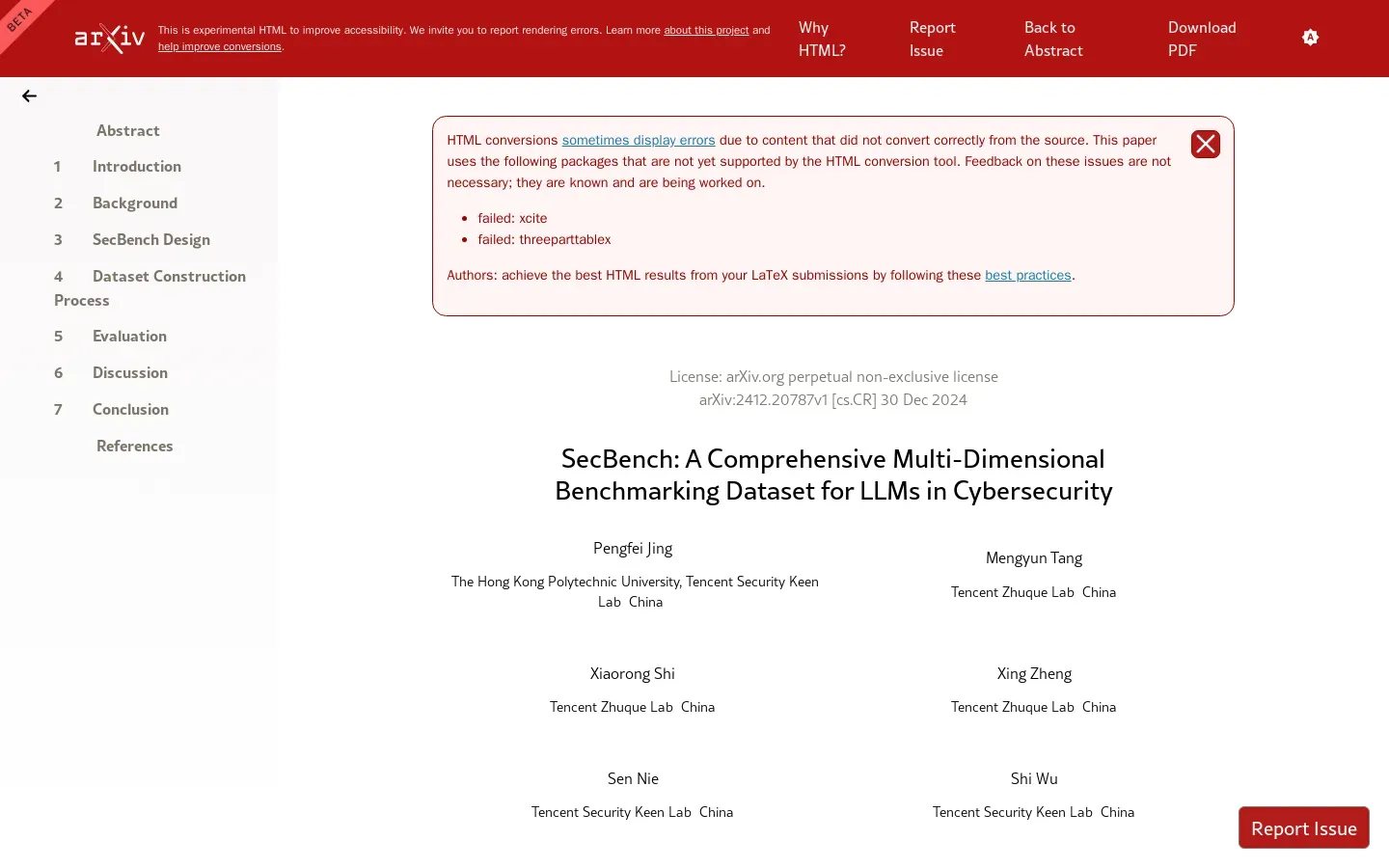
SecBench: Benchmarking Dataset for LLMs in Cybersecurity
/ 4 min read
Quick take - Recent research in cybersecurity has focused on developing automated threat detection systems, effective training programs, and innovative grading methodologies using large language models, aiming to improve the effectiveness of cybersecurity measures and prepare professionals for future challenges.
Fast Facts
- Automated Threat Detection: Research focuses on developing real-time automated systems that accurately identify and mitigate cyber threats with minimal human intervention.
- Cybersecurity Training Programs: Effective training initiatives are designed to enhance knowledge retention and practical skills among cybersecurity professionals.
- Innovative Grading Systems: Large language models (LLMs) like GPT-4 are utilized for grading cybersecurity tasks, allowing for more nuanced and objective assessments.
- Interdisciplinary Approach: The research combines insights from cybersecurity, education, and artificial intelligence, though scalability and bias in LLMs remain concerns.
- Future Directions: Emphasis on enhancing AI-driven cybersecurity tools and establishing standardized benchmarks for evaluating measures to ensure industry consistency.
In an era where cyber threats loom larger than ever, the quest for effective cybersecurity solutions has never been more critical. As organizations grapple with increasingly sophisticated attacks, the need for automated threat detection and response systems has surged. These systems promise to leverage advanced algorithms that can identify anomalies and respond to threats in real time, thus allowing human analysts to focus on strategic decision-making rather than mundane monitoring tasks. Yet, as we dive deeper into this realm, we must also consider the limitations and implications that accompany such technological advancements.
One of the key challenges in developing automated systems is the design of cybersecurity questions that facilitate accurate threat modeling. A recent initiative—a Cybersecurity Question Design Contest—aimed to crowdsource innovative question formats that could enhance the effectiveness of these automatic systems. This contest not only showcases community engagement but also emphasizes how essential it is to create relevant frameworks that machine learning models can interpret accurately.
As we advance our understanding of cybersecurity metrics, another fascinating development is the utilization of large language models (LLMs) like GPT-4 for labeling and grading data sets. This methodology streamlines the process of training automated systems by ensuring a more accurate classification of security threats. The potential for LLMs extends beyond mere data processing; they can also enhance cybersecurity training programs by providing tailored educational content based on real-time threat intelligence.
Yet, while these advancements are promising, they come with their own set of limitations. For instance, relying heavily on automated systems may lead to complacency among human operators, who might overlook critical insights that only human intuition can provide. Additionally, as these systems evolve, so too do the tactics employed by cybercriminals. The dynamic nature of cyber threats means that what works today might not be effective tomorrow.
In parallel, initiatives like SecBench, a benchmarking framework for evaluating security tools, have emerged to address these challenges head-on. By setting standard metrics against which different security solutions can be measured, SecBench aims to drive innovation and accountability in cybersecurity tool development. This ensures that organizations are equipped with effective defenses against evolving threats.
Moreover, the integration of tools such as OpenCompass further enhances our capabilities in navigating the complex landscape of cybersecurity. This platform provides a structured approach to understanding vulnerabilities and devising strategies for mitigation. It underscores the importance of collaborative efforts within the cybersecurity community to create robust solutions tailored to diverse environments.
As we look towards future directions in cybersecurity, it becomes evident that continuous evaluation and adaptation will be necessary for success. The interplay between automated systems and human expertise will shape how organizations defend against potential threats. It’s crucial to remember that technology should serve as an enabler rather than a crutch; maintaining a balance between automation and human oversight will be vital in crafting resilient cybersecurity frameworks.
In conclusion, while we stand on the brink of a new age in cybersecurity powered by innovations like automated threat detection and LLMs, we must remain vigilant about the limitations they present. The road ahead will undoubtedly feature challenges that require us to rethink our approaches continually. As we harness these advancements, fostering a culture of adaptability and collaboration within the cybersecurity community will be essential for staying one step ahead of those who seek to exploit our vulnerabilities. The future may hold uncertainties, but it also brims with opportunities for growth and improvement in safeguarding our digital landscapes.



